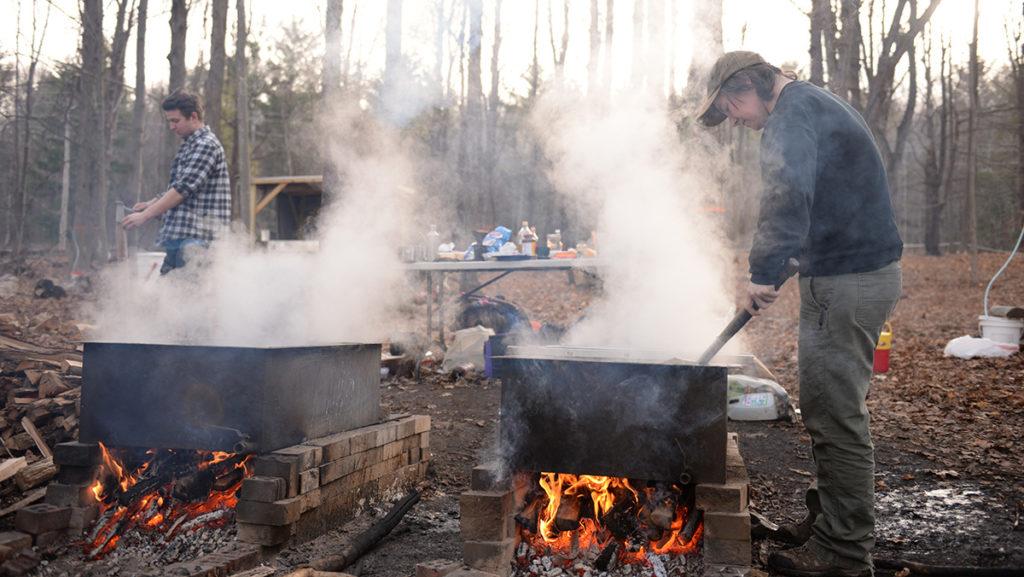It was 70 degrees in Ithaca for nearly a week this past February. While the quads outside of residence halls were full of people tossing Frisbees and lounging on the grass, the well-received warm period was troubling for some Ithaca locals and scientists.
The warm-to-cold weather pattern has made syrup production and landscape management difficult for faculty and staff at Ithaca College and also has beekeepers concerned about the overall health of their hives.
[gss ids=’24917,24924,24918,24922,24919,24920,24923,24927,24928′ carousel=’fx=carousel’ options=’loop=2&pause-on-hover=true&timeout=2000′]
The increasing variability in weather over the last few years is troubling, said Jason Hamilton, professor and chair of the Department of Environmental Studies and Sciences.
“The weather over the past 10 years has become less and less and less predictable,” Hamilton said. “With global climate change, this unpredictable weather is what’s predicted. Whether this run’s due to climate change or not, who knows? But it’s exactly what’s predicted by the models — that things are going to get increasingly unpredictable”
Jennifer Francis, a research professor at Rutgers University’s Institute of Marine and Coastal Sciences, said a large difference in temperatures between the middle-latitudes and the Arctic are what fuel the jet streams — large bands of air flowing around the hemisphere that carry weather — and this large difference also keeps these jet streams relatively uniform. But Francis said that because temperatures in the Arctic are rising at such a higher rate than they are in other areas, the jet stream has become less uniform.
“We’re noticing that the west-to-east winds are getting weaker as a result, and we know that when the jet stream is weak, it tends to take these bigger north-south swings,” Francis said. “Those big waves in the jet stream, or any waves in the jet stream for that matter, are what create the weather storms, the weather systems that we feel on the surface.”
Francis said what causes extreme weather events, such as the California drought, is when these big waves in the jet stream get “stuck” over a location and cause extreme weather events.
While this may seem like a distant concept, the effects of this weather are already seen by people in the Ithaca area.
[acf field=”code1″]
Syrup Production
Maple syrup is not easy to make. It starts with tapping maple trees for sap and waiting patiently for enough sap to collect, and if sugar–makers can get a few gallons of sap, they can make about a quart of syrup. It is a long process that requires specific conditions and a great deal of patience.
This year, though, the Non-Timber Forest Products class at the college gathered nearly 25 barrels of sap and boiled the sap for nearly 100 hours in an attempt to make syrup, but after making only 12 gallons of syrup from this run, the students had to dump sap from all other boils, as it went bad in the unusually warm weather. The class has never experienced a loss this large.
“I was disappointed,” said Tori Chamberlin, a senior environmental studies major and a teaching assistant for the class. “One of the big parts of this class is learning to work with variability, so it’s not a completely lost cause … but yeah, it’s still something you can’t help.”
Hamilton, who teaches the Non-Timber Forest Products class at the college, said the reason this year’s syrup-making process was difficult was the warmer weather and greater variability in the weather.
He said that in order to tap maple trees for sap, the daytime temperature has to be above 40 degrees, and the nighttime temperature has to below freezing. He said this weather typically begins in late January and early February, with the season’s typically tapering off around late March or early April.
“What’s been happening over the past few years is that syrup season has started to become much less predictable in terms of when it’s going to start and when it’s going to end,” Hamilton said. “It makes it very difficult to figure out when you should tap your trees. … This has been the weirdest year yet, in that there was a sap run in December, which is just absolutely unheard of.”
Hamilton said the biggest issue for the college with this early sap run was that it was during the fall semester and over winter break, and that the Non-Timber Forest Products class does not run during that period.
The warmer winter was mixed with sporadic rainfalls as well, which he said made it difficult to boil sap in their outdoor facilities. With all of these compounded, he said students collected barrels upon barrels of sap at one time and boiled the sap for 100 hours straight, which was unprecedented. But the warm streak in February caused the rest of their sap to go bad.
Chamberlin was helping boil sap during the 100-hour session and said it was particularly disappointing to have to dump the rest of their sap because it meant taking a valuable resource away from the trees themselves.
“It just so happened that, when we were boiling, it was warm, so the contamination happened that night,” Chamberlin said. “We had three barrels in the sugar bush that we just dumped because it got too warm. … You’re taking that sap from the trees, so that energy could have gone to the trees to help photosynthesize and everything.”
The students at the college are not the only ones feeling the effect of the warmer weather. Dan Beasley is the owner of SweeTrees, a small family business in Cicero, New York, just outside of Ithaca. He started making maple syrup with his grandparents when he was a child, but he and his family started a business out of it in 2004.
“We’ve only been doing this for a short amount of time in the grand scheme of things,” Beasley said. “In that amount of time, we start now about four to six weeks earlier than we used to. That real hot weather in the middle of February really messed us up and put a quick end to our season.”
Beasley said people who make maple syrup are typically pretty good at dealing with the conditions they’re dealt and making the best of it, but he also said the overall trend of the weather getting warmer is concerning.
“I’m 62, and it’s certainly not as consistent as it used to be, and I think anybody that wants to do maple syrup has to be ready constantly, even in December,” Beasley said. “It’s changed a lot in 15 years. If it changes this much in the next 15 … who knows? It’s going to affect more than maple syrup.”
Beekeeping
Maple syrup was not the only product that the Non-Timber Forest Products class makes that was affected by strange weather this year. Hamilton said the college had 100 percent loss of its bees this year, and other beekeepers across the country have noticed anywhere between 80 to 100 percent hive loss.
Senior Izzy Sibley, an environmental science major and the head beekeeper at the college, said all beekeepers lose a certain percentage of their bees from season to season, but that this year was particularly strange. Sibley said colony collapse disorder or varroa mites are always a big problem for bees, but that these didn’t seem to be the only reasons.
“This year, those beekeepers that treated for varroa mites saw just as much loss as the beekeepers who didn’t, so it’s one of the first years where we don’t really know why there’s such a large margin of death among the bees,” Sibley said.
Colony collapse disorder is when the bees in a colony suddenly leave the queen behind, though scientists are unsure why this happens. Varroa mites, on the other hand, are mites that prey upon colonies of honeybees as an external parasite. The mites feed upon the hemolymph — essentially, the blood — of an individual honeybee before jumping to another host, in the process spreading diseases among individual members of a colony.
Hamilton said some bee experts have proposed that the drought Ithaca had last summer could be a possible reason so many bees have died, as it could have put stress on the bees’ ability to make honey.
“Our honey production was down because of the drought making fewer flowers,” Hamilton said. “If it was tied to weather, it might have been tied to drought … but there are a lot of interacting factors. Maybe there was some sort of thing that stressed the bees a little bit that made them more susceptible to virus — we just don’t know about that.”
Borst, the vice president of the Finger Lakes Bee Club and former senior apiarist at Cornell University‘s Dyce Lab for Honey Bee Research, said he does not think the weather over the summer and during the winter had as much effect as others believe because he noticed that a majority of bees died before the winter even began. However, Borst did say that temperature variation this season did probably have a negative impact on some hives.
“Honeybees are adaptable, and that’s why they succeed,” Borst said. “While bees are able to adapt to some variations, there are other variations that they can’t adapt to. For example, if it gets very warm, they start going through their honey because they think spring is here, and then it snaps back. … That probably wiped out the ones that hadn’t already died in the fall.”
Borst said that the main problem with the weather has been that it’s too unpredictable for beekeepers to keep their bees healthy.
“The take–home message is more variable weather is what we’re afraid of,” Borst said. “If it moved a couple of degrees to be that much warmer and was spread out evenly, that would move all the plants forward. The bees would be fine. Variability is what’s really the most difficult consequence.”
Plant life
What may have been the most obvious indicator of strange weather patterns this year might have been plants’ leafing out earlier than usual. The warmer weather has caused an acceleration in the way plants have grown this year, Borst said.
“There’s a national map of the first leafing out of green leaves, and the whole nation was three weeks in advance than normal springtime leaf-out period in February, but then it just stalled out in March in the Northeast,” Borst said.
While this is unusual, it has a few detrimental effects. The Non-Timber Forest Products class at the college had its syrup season cut short because the trees began to bud earlier than expected, Hamilton said.
“There is variability in when [the syrup season] starts, but there’s not nearly as much variability in when it ends because it ends when the trees start expanding their branches and are starting to break bud,” he said.
The problem with trees’ budding earlier than expected is that the sap from budding maple trees produces a syrup that tastes much different from the syrup consumers are used to, Chamberlin said.
The variable weather has also made it more difficult to get the campus ready for spring and summer. Ernie McClatchie, director of facilities, grounds and maintenance at the college, said the weather has set back the normal schedule that grounds crews usually have in the spring by two to three weeks.
The future
All of these implications about the increasing variability in weather patterns have some producers concerned for their future. In particular, Beasley said he was worried about the future of the maple syrup business for his children.
“My desire … is for this to be passed down to any and all of my kids, whoever wants to continue it,” Beasley said. “For me, I think we’ll do OK, but for them, I’m not so sure. … There’s a lot of opportunity, but as far as maple syrup goes in this part of the state, I think we may be on the losing end of warmer weather.”
Even still, some still feel optimistic. Despite the setbacks that the Non-Timber Forest Products class had with its syrup production, Hamilton said the class is structured to provide a good amount of diversification in products produced — such as salves and carved utensils — so that the products the students make for their class business, South Hill Forest Products, are not completely devastated.
“The story is by no means one of doom and depression,” Hamilton said. “On the one hand, you could say this is part of farming, which is that, in good years, you have to save money for the bad years. … It was a stress test of our systems, and I would say we passed pretty dang well.”
But he said that if this pattern of increasingly variable weather continues, there should be greater concern.
Borst said the average person can help their local bees by buying products from their local beekeeper at the farmers market, planting flowers that bees like and not using insecticides that may harm bees. But bees are naturally pretty good at bouncing back, he said.
“Hope springs eternal, and spring is coming back, and we can just start again,” Borst said. “You can go from a handful of bees, and they repopulate the hive, and they start over again. That’s the inspiring part about them — they show us you can start from very little and go back to where you were.”








